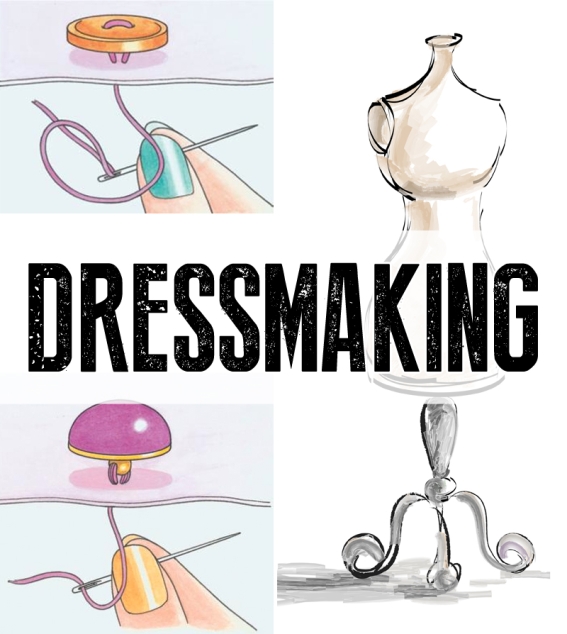
Dressmaking Techniques
Discover all the essential techniques to take your dressmaking to professional level
How to sew a two-hole button




Secure the thread and bring the needle to the surface at the position of the button and bring it through the button from the back.
Take the needle down through the other hole and through the fabric, leaving a small gap between the button and the fabric.
Repeat the above to work a few stitches through the button holes. Then take the needle around the threads between the fabric and the button to form a shank.
To finish, work on the wrong side and make a couple of stitches through the threads to secure.
How to sew a four hole button
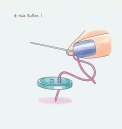
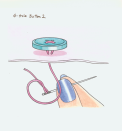
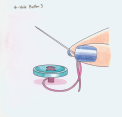
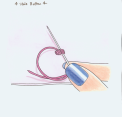
Secure the thread and bring the needle to the surface at the position of the button and bring it through the button from the back.
Take the needle down through the other hole and through the fabric, leaving a small gap between the button and the fabric.
Repeat the above to work a few stitches through the button holes, working through all four holes, either to form a cross or parallel bars. Then take the needle around the threads between the fabric and the button to form a shank.
To finish, work on the wrong side and make a couple of stitches through the threads to secure.
How to sew a button with a shank
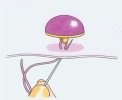
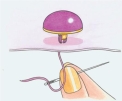
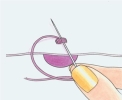
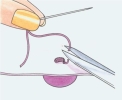
Secure the thread and bring the needle to the surface at the position of the button and bring it through the hole in the shank. Take the needle down through the fabric and back to the surface again.
Repeat, making several stitches through the shank and fabric.
Work on the wrong side and make a couple of stitches through the threads to secure.
Once the threads are secure, fasten off.
How to stitch woven skirts to knit tops
Stay stitch the bottom edge of the T-shirt within the seam allowance. Take care to avoid stretching the fabric.
Use plenty of pins to hold the layers together and ensure that the knit layer doesn’t distort during stitching.
Regularly stop and lift the presser foot as you stitch to avoid distortion and fabric creeping.
How to slip stitch a hem
There are many techniques for stitching a hem by hand, however this pattern suggests slip stitching it in place for a neat finish which encases the raw edge and does not show any stitching on the front. Do this by pressing under 6mm, followed by the hem depth. Slide the needle through the fold and take a small stitch into the opposite fabric. Continue along the length of the hem.
How to sew with stretch fabrics
Follow our top tips and create beautiful garments with stretch fabrics!
Most machines now have a stitch especially for stretch fabrics, it’s slightly angled and will stretch with the fabric so shouldn’t crack seams. Use a serger or attach a walking foot to feed the fabric without it stretching as you sew. Opt for a Universal H, Ballpoint H-SUK or Stretch HS needle.
Sewing with knitted fabrics can be tricky, but the key to handling this fabric is pretty simple. Selecting the correct needle is a vital part of stitching stretch fabrics. When pinning, ensure all pins are kept within the seam allowance, to avoid creating holes in the fabric. A good way of stabilising the fabric when sewing is by sandwiching tissue paper in between the fabric layers. This prevents the slippery fabric moving against each other. Once you've sewn your seam, the paper can be removed by tearing is away.
Knit fabrics stretch across your body, so straight stitches will often break when the material is pulled tightly. When using your standard sewing machine, it's best to either use a stretch stitch that's built into your machine or a narrow zig zag stitch.
How to sew with slippery fabrics
Use plenty of pins and if the fabric is particularly slippery, it may be an idea to tack the seam first. Cover your work surface with a sheet of cotton before laying out your fabric in a single layer for cutting. Only place pins within seam allowances to avoid marking the fabric. Always use a new, sharp needle.
How to sew with pile fabrics
Be sure to use plenty of pins; pile fabrics work against each other when they are being stitched together. Position pins at right angles to the edge of the seam and if you stitch carefully, you can sew over them and the seam should not move.
How to sew a double-fold hem
Turn the garment inside out and trim the ends of the seams that will lie within the hem to reduce bulk. Press firmly. Turn up the hem to the desired length and pin near the fold. Check that it is lying straight, then tack close to the fold. Cut a length of card to the desired depth. Use this as a template to mark off the hem, allowing an extra 1cm for turning under, and trim off the excess. Press in 1cm all along the raw edge, then pin the hem in place.
Tack another line of stitches along the top fold. If you are making an A-line skirt, you might find there is excess fabric at the top fold to accommodate. If this is the case, run a short line of easing stitches to help spread the excess.
Use uneven slip stitch to work the hem. Bring the needle up from inside the fold, then pick up two or three threads from the main fabric. Run the needle along the inside of the fold again, then bring it out and take another tiny stitch in the main fabric. Continue to the end of the hem.
How to make a thread chain
Thread a needle with a long length of thread and secure it on the inside of the curtain where you want the chain to start; bring the thread through to theright side. Take a small stitch through the fabric and draw the thread through, leaving a 10cm loop. Hold the loop open with the thumb and first two fingers of your left hand, holding the working end of the thread with your right thumb and index finger (swap if you're left-handed).
Using the second finger on your left hand, reach through and hook the working thread end, and then draw it through the loop to start a new loop. As you pull the new loop through, the first loop will start to slide off your other fingers and become smaller as it draws down close to the fabric. Hold the new loop as you did with the first and continue making the chain in the same way until it is the desired length. To secure the end, simply slip the needle through the last loop and pull it up tight. Stitch the end of the chain to the curtain and secure on the reverse.
How to make a corded button loop
Cut a length of fine piping or blind cord at least twice the length of the loop. Fold the loop piece in half lengthways, right sides together, with the cord inside. Pull the cord halfway out of the top, then machine stitch across the top of the loop fabric using a zipper foot, sewing to the centre of the cord.
Turn and stitch down the length of the loop fabric close to the cord. Secure the stitches at the end, but do not close it. Pull the end of the cord out of the open end of the loop until it turns inside out. The loop is now right side out with the cord inside. Cut off any surplus.
How to insert a concealed zip
Stitch the concealed zip into the back opening using a zipper foot or a concealed zipper foot. Fold and press the seam allowance along the two sides of the back opening. Open out the seam allowance and with the right side of the fabric facing, place the opened zip face down matching the teeth to the crease line in the seam allowance. Pin in place.
If you are using a concealed zipper foot, place the teeth of the zip into the groove and, as you sew, the foot will uncurl the teeth and the stitching will be placed right alongside the teeth. If you are sewing with a normal zipper foot, you will need to uncurl the teeth with your finger tips; stitch to the top of the centre back seam.
It is impossible to sew to the end of a concealed zip, so leave approximately 3cm of the base unstitched. Back stitch, then sew the other side of the zip in place. Carefully thread the zip pull through to the right side at the top of the centre back seam and pull up to close.
How to stitch a French seam
A double seam that encloses the raw edges of the seam allowance. Allow for a total 1.5cm seam. Stitch the seam wrong sides together using a 7mm seam allowance, then trim to 5mm and press to one side. Press the seam back on itself along the seam edge, with right sides together and sew a second 7mm seam. Finish by pressing the seam to one side. Where two French seams meet, match the seam lines wrong sides together and lay the seam allowances away from each other to reduce bulk.
How to create gathering stitches
Working on the right side of the fabric, tack two rows of straight, long, parallel stitches in the seam allowance; one just inside the stitching line and the other 6mm away. Be sure to leave long thread tails. Secure one end of the thread tails so they don't pull out accidentally. Pull the loose bobbin thread tails to gather the fabric, sliding the fabric along the threads. Loosen the tension on the needle thread so the bobbin threads are easier to pull. When the gathered piece matches the length of the corresponding ungathered piece, pin the layers together, adjusting them so they are evenly distributed. Change to a shorter stitch length and sew the two layers together. If the fabric to be gathered is long, divide it in halves or quarters and tack and gather each section independently.










































